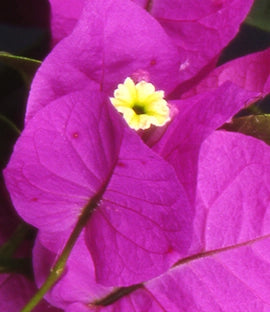Plant Hoarder
Bougainvillea, Elizabeth Angus
Bougainvillea, Elizabeth Angus
Couldn't load pickup availability
Share
Bougainvillea ‘Elizabeth Angus’: Elegance in Every Bloom
If you’re looking for a bougainvillea that brings together bold beauty and graceful charm, Bougainvillea ‘Elizabeth Angus’ is your answer. This stunning variety is known for its deep magenta to rich purple bracts, which cover the plant in waves of vibrant color throughout the warm months. Whether it’s climbing, trailing, or cascading, this plant brings a sense of luxury, energy, and tropical warmth to every garden space it touches.
But best of all? It’s easy to grow, incredibly drought-tolerant, and loves to bloom with very little fuss.
What Makes ‘Elizabeth Angus’ So Special?
Bougainvillea ‘Elizabeth Angus’ stands out in the garden like a royal cloak of color. Its saturated purple-pink bracts are bold and commanding. Against deep green foliage, they create a show that stops visitors in their tracks.
Here’s what gardeners love most:
-
Rich, saturated color from spring through fall
-
Fast, vigorous growth with trailing or climbing vines
-
Minimal water needs once established
-
Long bloom season in warm weather
-
Perfect for climbing, spilling, or shaping
This variety offers both the vibrance of bougainvillea and a slightly more refined look, making it a favorite for formal gardens, trellised entries, and sun-drenched patios.
Where to Plant Bougainvillea ‘Elizabeth Angus’
Let’s dream big for a moment. ‘Elizabeth Angus’ can be the centerpiece of your garden or an accent that adds drama.
Ideal uses include:
-
Climbing a pergola, trellis, or archway – Let it reach for the sky with a wall of purple blooms.
-
Draping over retaining walls – Its vines create a soft, colorful curtain.
-
Growing in large containers or patio pots – Let it trail or train it upward for vertical color.
-
Framing a sunny entry or courtyard – Welcome guests with flowers from spring to fall.
This plant loves to climb and sprawl, so give it support or room to roam—and it will reward you with color beyond your expectations.
Growing and Caring for ‘Elizabeth Angus’
Good news: bougainvillea is low-maintenance once you get the hang of it. Follow these care tips, and yours will flourish.
☀️ 1. Full Sun Is Essential
No shortcuts here. Bougainvillea needs at least 6 hours of direct sun daily—and more is even better.
More sun = more flowers. Less sun = more leaves and fewer blooms.
Plant it in the sunniest part of your garden or patio to get those long-lasting displays of color.
🌱 2. Soil Must Drain Well
This is a plant that hates soggy roots. Think dry, gritty, and fast-draining.
-
In the ground: Sandy or loamy soil is best.
-
In pots: Use a cactus/succulent mix or add perlite to regular potting soil.
-
Avoid wet, clay-heavy areas.
If you’re planting in a raised bed or slope, you’re already on the right track.
💧 3. Water Lightly, Let It Dry
Once established, bougainvillea is highly drought-tolerant. In fact, it blooms more when you withhold water.
-
Water deeply at planting time.
-
Then let the soil dry completely before watering again.
-
For potted plants: water when the top inch of soil is dry.
Too much water = no blooms. Dry spells = show-stopping color.
🌸 4. Feed Just Enough
A little food goes a long way. You don’t need to overdo it.
-
Use a low-nitrogen fertilizer (like 5-10-10) every 4–6 weeks in spring and summer.
-
Avoid high-nitrogen blends—they’ll give you foliage, not flowers.
-
Look for “bloom booster” or “flowering plant” formulas.
Fertilize during the growing season, then ease off in winter.
✂️ 5. Prune to Shape and Encourage Growth
Pruning is your friend. It helps keep the plant tidy and encourages more blooms.
-
Trim lightly after flowering cycles to shape the plant.
-
Cut back more deeply in early spring to promote fuller growth.
-
Remove any dead or twiggy branches to improve air circulation.
This plant responds very well to pruning. Don’t be afraid to give it a good cut when needed.
Growing in Containers
Don’t have garden space? No problem.
‘Elizabeth Angus’ thrives in containers if you:
-
Choose a large pot with plenty of drainage
-
Use well-draining soil mix (succulent or cactus mix is ideal)
-
Place it in full sun
-
Allow the soil to dry between waterings
-
Feed it monthly with a bloom booster
Add a trellis or let it spill naturally over the edges. Either way, it’s stunning.
Bonus: Containers make it easy to move indoors during cold snaps if you live in cooler zones.
Winter and Cold Weather Tips
Bougainvillea ‘Elizabeth Angus’ is best suited for USDA Zones 9–11, but it can grow in colder zones with care.
For chilly climates:
-
Grow it in pots that can be brought inside before frost
-
In-ground plants should be mulched heavily in fall
-
Use frost cloths on cold nights
-
Reduce watering during the winter
If the top growth is damaged, don’t worry—it often regrows from the roots in spring once the weather warms up.
Common Questions About ‘Elizabeth Angus’
Why is it not blooming?
Most common reasons:
-
Not enough sun
-
Too much water
-
Too much nitrogen fertilizer
Fix those, and blooms will return.
Is it thorny?
Yes, like other bougainvilleas, it has sharp thorns along the stems. Wear gloves when handling and plant away from high-traffic areas.
Can I grow it indoors?
Not ideal. Bougainvillea loves heat, sun, and airflow. It may survive indoors near a sunny window, but blooms will be limited. It's best grown outdoors during the warm months.
Is it toxic to pets?
Bougainvillea is not highly toxic, but the sap and thorns can irritate. Best to keep curious pets away from it.
A Garden Classic with Regal Flair
Bougainvillea ‘Elizabeth Angus’ is bold but refined, powerful yet graceful. It offers a garden experience that’s drenched in color, rich in texture, and effortless to maintain once established.
With just sun, drainage, and a touch of tough love, it will bloom for months—bringing tropical energy and royal color to everything from fences to balconies.
It’s the kind of plant that asks for little, but gives you so much—and for that, it earns a place of honor in any garden.








